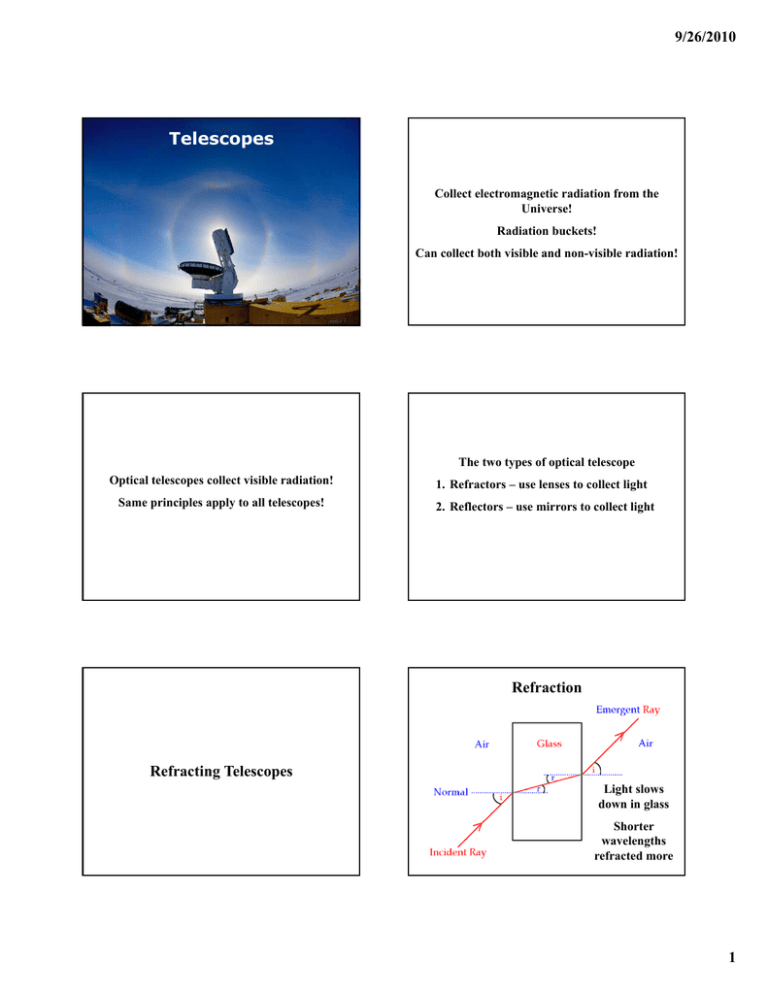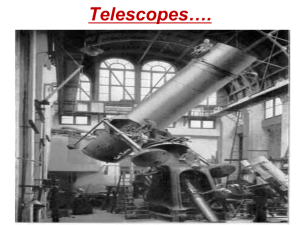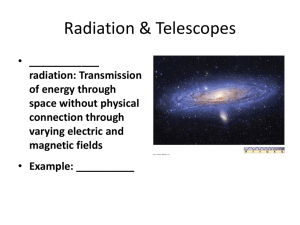Telescopes 9/26/2010
advertisement

9/26/2010 Telescopes Collect electromagnetic radiation from the Universe! Radiation buckets! Can collect both visible and non-visible radiation! The two types of optical telescope Optical telescopes collect visible radiation! 1. Refractors – use lenses to collect light Same principles apply to all telescopes! 2. Reflectors – use mirrors to collect light Refraction Refracting Telescopes Light slows down in glass Shorter wavelengths refracted more 1 9/26/2010 Dismembered Polar Bear? Example: Objects seen under water appear distorted A convex lens collects light and brings it to a focus A Refracting Telescope A second eyepiece lens magnifies the image An Amateur Refracting Telescope The image formed in an astronomical telescope is upside down and back to front: 2 9/26/2010 The world’s largest refractor The 1m telescope in Yerkes, WI Chromatic Aberration Refraction in a prism splits sunlight into its component colors! This is unwanted in a refracting telescope! One partial solution – a compound lens Other problems with refractors 1. Large lenses deform under gravity 2. Air bubbles trapped in glass distorts images 3. Glass very expensive 4. Objective has to be held at edges, partially blocking light Problem – cannot be removed completely! 3 9/26/2010 Objective lens clamped at the end of the telescope Reflecting Telescopes Reflection A concave mirror collects light and brings it to a focus Law of reflection: i = r Reflectors come in many configurations! Newton built the first reflecting telescope 4 9/26/2010 An Amateur Reflecting Telescope Reflectors can be made much larger than Refractors! Can be completely removed! The 5 m Hale telescope on Mount Palomar in California Spherical Aberration Large mirrors can take many months to fabricate! Another advantage over refractors! 5 9/26/2010 The Hubble Space Telescope (HST) HST was found to suffer from spherical aberration when it was launched in 1990 In 1993 HST was serviced in order to fix the problem It now has clear vision! One solution: Multiple Mirror Telescopes Large mirrors over 5 m in diameter deform under their own weight! Example: The 10 m Keck telescopes on Mauna Kea in Hawaii Made of 36 separate 1.8 m mirrors 6 9/26/2010 Another Solution – Active Optics Example: The 8 m Subaru telescope on Mauna Kea in Hawaii Use a single, large thin mirror and place sensors at the back that continuously maintain its shape Larger apertures collect more light! Aperture = the size of a telescopes mirror or lens! Bigger is better! light gathering power (LGP) of a telescope depends on the area of the main mirror or lens area = πD2/4 LGP → area → D2 D ↑ LGP ↑ Giving us brighter images and the ability to see fainter objects! D x 2 LGP x 22 = 4 D x 3 LGP x 32 = 9 7 9/26/2010 The larger the aperture, the sharper the images and the more detail that is seen! Large telescopes are capable of seeing fine detail in images! However, they are limited by the blurring effects of the Earth’s atmosphere! Two stars seen from space The same stars seen from the Earth’s surface! Image Sharpening using Adaptive Optics Adaptive Optics (AO) By firing a laser up into the sky close to the target object, atmospheric turbulence can be subtracted producing sharper images! 8 9/26/2010 Modern Astronomy Atmospheric Transparency Before radiation is collected it must first pass through the Earth’s atmosphere! Not all wavelengths get through!! Mauna Kea, HI Wavelength Transparency Can observe Visible, radio Good from ground Blocked by far-UV, X-ray, upper only from space Gamma Ray atmosphere Blocked by water From tops of IR, Microwave vapor in lower tall mountains atmosphere Elevation: 13,700 ft 9





